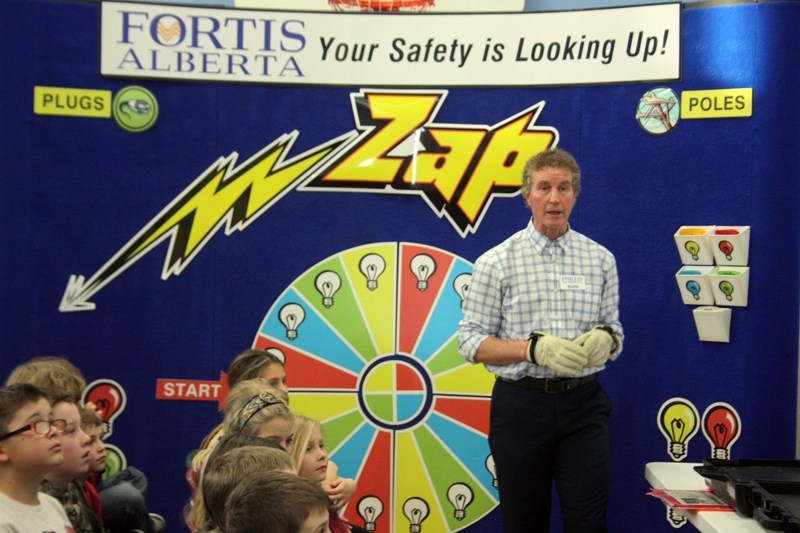ZAP, an electrical safety program that is sponsored by Fortis Alberta in conjunction with the Multicultural Heritage Centre’s school program, came to Dunstable Elementary School on Monday, Jan. 11, for a presentation to the children in Grades 3 to 6.
Jeanette and Keith Smith, a husband-and-wife team based out of the Multicultural Heritage Centre’s offices in Stony Plain, are safety education coordinators who travel around the province to drive home the importance of safety in the home and outside.
“Did you know that one zap of electricity can travel 297,000 kilometres in a second?” Jeanette Smith asked the approximately 30 children in attendance.
According to Smith, that amount of energy can travel around the entire planet more than seven and a half times over the duration of that one second.
“At home, I have an atlas and it has a map of the whole world printed on two pages in the middle of the book,” Smith explained, adding that on the corner of one of the pages, the book has information about distances relative to the Earth’s equator. “That’s how I figured out that one zap of electricity can travel around the world seven and a half times in a second,” she said.
“Electricity really is a wonderful and powerful form of energy, and it has certainly changed the way we live our lives today, but it is also incredibly dangerous.”
Explaining what key words like current and voltages meant, words that the Grade 5 and 6 students will be studying about in their upcoming electricity and magnetism units, along with terms like insulator and conductor, Smith used visuals and props to educate her audience.
According to Smith, there are thousands of volts running through the power-lines that hang above our streets, yet household appliances plug into outlets that produce a much lower voltage of around 120 – the amount necessary to operate things like hair-dryers and related items.
“Our wall outlets are wired specifically to deliver that level of voltage,” she added.
“It only takes 120 volts to kill an adult, and because a child’s body mass is less than a grown person, the amount of electricity required may be much less as well,” Smith said, adding that the hazard board depicted a number of household situations where a potentially fatal electrocution could occur.
“All kinds of metals are really good conductors of electricity, and gold is one of the best despite it being the most expensive,” Smith said, adding that water and the human body are both excellent conductors as well. “Science tells us the human body is 70 to 75 per cent water and that is why we are excellent conductors.”
“Electricity however, does not want to stay inside our bodies,” Smith said, adding that it uses our bodies to get to the ground and that it always chooses the shortest path to achieve that result. “Because our bodies are filled with water and we spend our whole lives pretty much attached to the ground, we become wonderful highways for electricity to use to get to the ground.”
The exact opposite of a conductor is an insulator, Smith said, explaining that an insulator, despite sounding like something beneficial, in this case acts as a sort of shield against the flow of electricity.
“Any substance that will not let electricity pass through it, that substance is an insulator,” she said. “Rubber, plastic and glass are all really good examples of insulators.”
Alana Antonelli, manager of corporate communications for Fortis Alberta, said that every year the ZAP program teaches more than 4,500 students in Alberta how to live and play safe around electricity.
“By teaching kids about safety as part of their science programs, we hope to prevent future accidents before they happen,” Antonelli said, adding that it is the aim of Fortis Alberta to present practical electrical safety lessons to students in a fun way.
“The things they learn from us and the safety education coordinators can be used right away, whether it is at home, at school, or even at ordinary play.”
According to Keith Smith, a variety of items including rubber insulated gloves that utility workers use on the job and a sample of the cable used to provide our communities with power were on display.
“We had some things for the children to see and touch, items such as hairdryers that could be connected to electrical sources incorrectly,” Smith said, adding that the majority of the items were used during the presentation to illustrate important points like not plugging in more devices into a wall than an ordinary outlet can safely handle.
“There is at least 138,000 volts of electricity that passes through the lines above our heads and buried beneath our feet,” Smith told the children, adding that if that much electricity went through a person, there would be a massive burst of heat and light, and it would most likely result in death or serious injury.
The moral of the story, Smith said, is to be extra careful around electricity and to not go into places that danger signs warn you against.



.jpg;w=120;h=80;mode=crop)